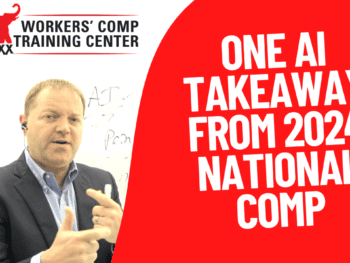
Take the First Step with Injury Prevention
The best first step in the quest to reduce workers’ compensation program costs is to prevent injuries from occurring. While every injury cannot be eliminated, there are countless things stakeholders can do to reduce their frequency and severity.
- Emphasize safety constantly: Safety should be emphasized constantly. It can be discussed at the start of each work shift or at least every week. It should be a topic of discussion at every staff meeting, and internal newsletters should have at least one reminder or tip on how to make the workplace accident-free.
- Practice what you preach: Safety should be a part of everyone’s workplace habits. This needs to include the supervisor, management, and the C-suite. Enter the workplace with the mindset that everyone must act safely, even alone.
Click Link to Access Free PDF Download
- Empower the Safety Committee that can make change happen: The company safety committee must be able to implement change and make it happen. This includes members who can communicate concerns and take the necessary steps to implement change.
Every employee should also feel comfortable reporting safety concerns without repercussions.
Emphasize Injury Reporting and Response
Riches and treasure can also be found in having a best-in-class injury response and reporting system. Countless studies demonstrate that better results happen when an immediate response to a work injury is reported within 24 hours. Now is the time to set the course in the right direction on these issues.
- First Aid: Kits should be adequately stocked and checked monthly to ensure all items are supplied. Kits should contain the items needed to respond to injuries commonly associated with the facility in which they are located. First aid training should be included in annual safety training to ensure that anyone can respond to a work injury.
- Assessment of Injury: Mistakes are often made when a work injury is not correctly diagnosed. Dividends can be added to any workers’ compensation program by providing access to telephonic nurse triage services around the clock. These services are staffed by nurses and other medical professionals who can assist anyone in applying appropriate medical care following a work injury.
- Post-Injury Follow-up: All supervisors and managers should participate in the post-injury process. This can include allowing these people to drive their employees to receive non-emergency medical care following an injury. Sending a “get well soon” card also builds employee morale.
Once the injured employee is stabilized, the next step is reporting the work injury. Insurance carriers and third-party administrators can help guide the way to the jackpot by providing their insureds with easy-to-use injury reporting platforms. Smartphones and Internet access are commonplace. Now is the time to use these tools to assist stakeholders in reporting work injuries accurately and precisely. They can also be used to preserve evidence.
FREE DOWNLOAD: “Step-By-Step Process To Master Workers’ Comp In 90 Days”
The final piece of the puzzle must include efforts to return the injured employee to work. Numerous studies in the claim industry have concluded the following about getting an employee back to work in a timely manner:
- There is an increase in workplace morale – employees feel valued;
- Injured employees receive less medical care and require less conservative medical treatment modalities; and
- Less money is spent on claims, including a reduced chance of a claim being litigated.
Now is the time to implement a return-to-work program in your place of employment.
Conclusions
The uncharted waters of a workers’ compensation claim pose many challenges to those stakeholders who seek fame and fortune. Now is the time to take on this challenge by seeking to prevent injuries from happening in your workplace. It is also crucial to emphasize injury response and reporting. The final step must be to encourage return to work efforts.

Contact: mstack@reduceyourworkerscomp.com.
Workers’ Comp Roundup Blog: http://blog.reduceyourworkerscomp.com/
Injury Management Results (IMR) Software: https://imrsoftware.com/
©2024 Amaxx LLC. All rights reserved under International Copyright Law.
Do not use this information without independent verification. All state laws vary. You should consult with your insurance broker, attorney, or qualified professional.
FREE DOWNLOAD: “Step-By-Step Process To Master Workers’ Comp In 90 Days”
















